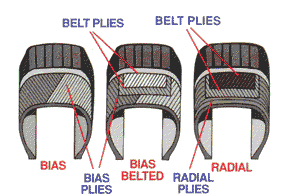Over the many years that we have been in business customers have brought to us many tire questions and misconceptions. Here you will find some interesting facts and tips about tires.
Tire Tips
- I have 275/80R22.5 can I replace them with 295/75R22.5 and can I ride them next to each other?
Yes you can. They are nearly the exact same size tire and are both considered to be low profile 22.5 tires. The 295's are .05" taller than the 275's which equates to about the size of a pencil point.
- What is the difference between Bias and Radial tires?
Tires are constructed with many cords through out the tire inside the rubber. Bias tires have nylon cords that run through them and Radial tires have steel cords. Bias tires are an older construction method and will provide a stiffer tire. Radial tires are a newer construction method and provide a softer ride with more give to the side walls.
- I have an object stuck in my tire, can it be fixed?
We can repair tires with a hole up to about the size of an average Sharpe marker as long as the hole is in the tread surface and farther than an inch away from the shoulder of the tire. Tires with larger holes or with holes not in the acceptable tread surface can be repaired but they will need to be sent out to be vulcanized. We do not vulcanize tires at our location. If the damage is within three inches of the bead of the tire it cannot be repaired. Repaired tires should not be put back on the steering position.
- My tire has a large chunk out of the side and the cords are showing. Can you take it off the rim and flip it around to the inside so no one can see it?
Believe it or not, someone really did ask us this question. The answer is absolutely not the tire must be replaced. You wouldn't want your friends or family driving next to dangerous truck tire and I wouldn't want mine driving next to your truck with a potential accident ready to happen at any moment.
- What is the minimum tread depth I can have on my truck tires before I need to replace them?
The minimum tread depth for steer tires is 4/32-inch, and 2/32-inch for any other wheel position.
- Why are my tires wearing irregularly?
That is a question with too many answers. Possible causes include over or under inflation, king pins, front rear or trailer alignment, road conditions, over loading tires, etc. I found this article useful when trying to determine the cause of irregular wear:
- Can I run that new tire next to my almost worn out tire?
No, tires must match in height when they are run next to each other. If you run a tire that is taller than the one that it will be matched up with the taller tire will carry the greater percentage of the weight. That will lead to the taller tire wearing out much faster, having irregular wear, or even blowing out.
Elite Tire International, Inc.
Specializing in Used Truck Tires, Wheels, and Casings
- This is an example of a pulled body ply on the side wall of a truck tire (right). This happens when one or more steel cords inside the tire breaks. This creates a weak spot in the tire because the rubber is no longer supported by the steal cord reinforcement inside the tire. Hitting pot holes or curbs can be a cause of this type of tire failure. This tire would need to be replaced because it will eventually blow out.
- This is an indication of an impact break (left). As the name implies this kind of tire damage is caused by the tire hitting, or impacting, something such as a curb or a pot hole. The tire may not blow out immediately after impacting an object. When you hit something hard it will cause damage to the cords inside the tire. Over time the stress from the tire rolling and heating up will cause more and more damage to that area until the tire finally gives up and blows out. You may hit something one day and a day or a week later it blows out. When it does blow out and the side wall has a line break from the tread toward the bead it is from an impact. This is a non-adjustable tire.
- This is an example of a zipper rupture (right). This is caused by running a tire very under inflated. When a tire runs with very little air, or "run flat", it makes the tire squash while being run which puts a lot of force on the steel cords in the side wall. If you get a flat tire on the road and run it while it is flat there is a good chance that when the tire is inflated again it will blow out resulting in a zipper rupture.
- Does this mean that my recap tread is pealing (left)? No, that is called the recap overflow. It is purely cosmetic. When a recap tire is made the recapper will grind off the original tread and will grind some of the shoulder to make a good surface for the new tread to adhere to. After the new tread is secured there may still be some rough areas of the shoulder that are visible. The recapper will place a thin strip of rubber over that shoulder area to make the tire look clean. You can see in the picture to the right where the rough area is not completely covered by the overflow. That piece can fall off completely without effecting the integrity of the recap tread at all. If the actual tread can be lifted off the tire casing then there is a problem.
